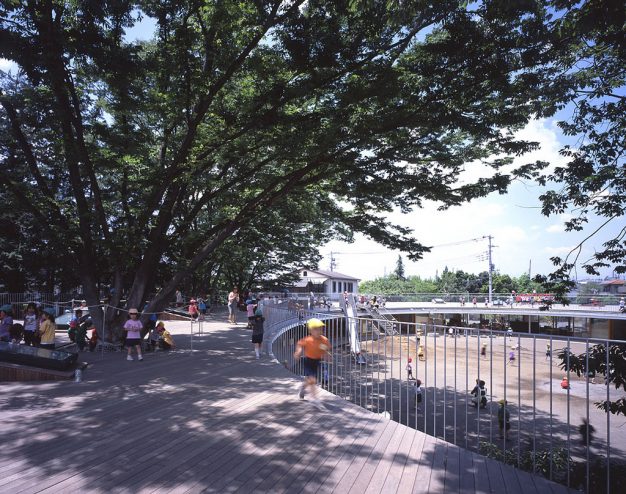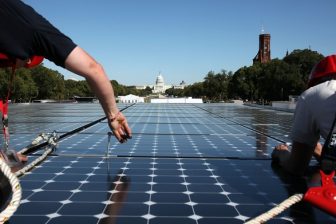
Fuji Kindergarten: the key to better childhood
There is a kindergarten outside Tokyo that was planned with children in mind. It is the kind of amazing place that all children dream about. The architects Yui and Takaharu Tezuka designed it in 2007, taking inspiration from their own daughter and son.
The Fuji Kindergarten’s school director wanted a really special kindergarten for his young scholars and he had some bizarre ideas sometimes; he wanted a roof without a handrail and a safety net from the edge of the roof, allowing children to fall off. Naturally, not all of his ideas were feasible, but the Tezukas were able to nevertheless find practical solutions for his overall vision.
The architecture created with kids in mind
Tezuka Architects planned an oval-shaped school with a flowing, continuous roof. This idea was inspired by observing their children at play; all children, in fact, like to run in circular shapes. The roof has a vertical handrail, with bars quite far apart to allow swinging with hands and legs. About this, Takaharu Tezuka affirmed, “Chimpanzees do the exact same thing — it’s a kind of instinct. And the way they do that is so childlike.” Furthermore, the roof is built as low as possible so that teachers can see their children on top of it, and children can sit there whenever there is a show, to get a better view of events.
The idea of the kindergarten’s principal about a safety net where children can fall off was kept around the huge three trees that come out from the roof. Here, children can climb on and play around the tree because they are protected by the net. Sometimes more then forty children at a time will be playing around each tree; the trees themselves are large and robust enough not to sustain damage.
Skylights in the roof bring daylight into interior classrooms and allow children to look out: useful if they are trying to find a friend! As well as this connection between up and down, there is also a connection between all the classrooms; indeed, there are no walls inside. This idea arose from research that shows children get nervous in a locked and quiet space, as opposed to when they are in a large and open place where they have freedom to move.
For indoor activities, it was considered important to deviate from the normal configuration of a learning environment. Here, Tezuka Architects used furniture that enabled greater dynamics and variability within the classroom; for instance, kits made from wooden boxes, which can be used for free construction and movement.
How children stay in the place
Fuji Kindergarten is the perfect place to encourage the socialisation and cooperation of children; there is no great intrusion from adults, and children are free to take decisions and to move without constraint as they explore and create their own world.
The innovative ‘living roof’ is so well used that children are estimated to cover an average 4,000m a day in active movement, thus helping them to acquiring athleticism and muscle strength and well as improving their sense of balance. And, of course, it is well established that children with freedom to move and play, also develop high levels of concentration and creativity for their lessons.
Takaharu Tezuka affirmed: “My point is don’t control them, don’t protect them too much, and they need to tumble sometimes. They need to get some injury. And that makes them learn how to live in this world. I think architecture is capable of changing this world, and people’s lives. And this is one of the attempts to change the lives of children”.
Author: Chiara Carlucci
Photo Credit: Photo by 準建築人手札網站 Forgemind ArchiMedia
Resources:
Takaharau + Yui Tezuka, Nostalgic Future / Erinnerte Zukunft, Jovis Editor, 2009;
Ehsani, M , F. Fuji Kindergarten, Journal of Arts and Architecture. No.32, P.104, 2014;
http://www.tezuka-arch.com/english/index.html
https://www.ted.com/talks/takaharu_tezuka_the_best_kindergarten_you_ve_ever_seen?language=en




